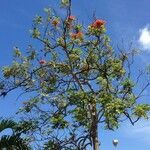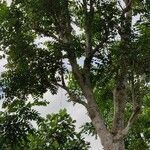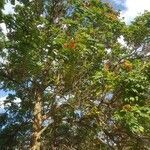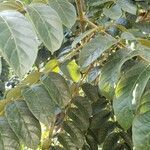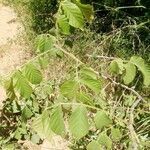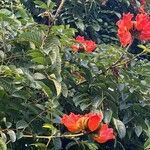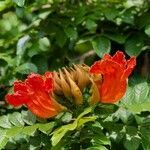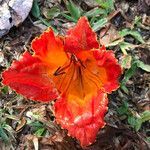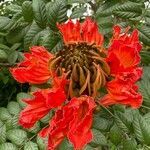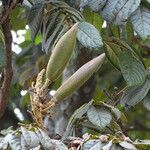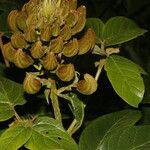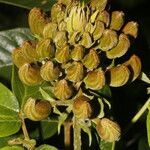Evergreen tree to 15 (–25) m high, often with buttressed trunk or multistemmed; bark deeply fissured. Leaves opposite, pinnate, to 50 cm long; leaflets (3–) 9–19, ovate-lanceolate or ± elliptic, 4–12 (–15) cm long, 2.5–8 cm wide, cuneate base, entire margin, acuminate apex, sparsely puberulent, with 2 or 3 pale domed glands on the underside towards the base close to the junction with the leaflet stalk; lateral petiolules 2–4 mm long; rachis with brownish hairs; petiole to 6 (–7.5) cm long. Flowers in terminal ± flat-topped clusters, hairy at first, with brownish-hairy pedicels. Calyx spathe-like, 4–7 cm long, leathery, split on one side, bent back, brown/rusty appressed-pubescent on outer surface, glabrous on inner surface. Corolla campanulate (bell-shaped) and abruptly narrowed at the base (somewhat tulip-shaped), 9–13 cm long, orange to blood red/scarlet, slightly 2-lipped, swollen on one side, the lobes 2–3 cm long, crisped (the frilly-crinkled margin often yellowish). Stamens 4, sometimes slightly protruding. Capsule oblong-linear, somewhat flattened, 15–25 (–30) cm long, 3.5–5 cm wide, woody; seeds numerous, flat, with membranous, hyaline marginal wing, c. (1–) 2 × 2.7 cm (including surrounding wing).
Tree to at least 25 m tall and 40 cm d.b.h. Leaves imparipinnate, usually 9-15-foliolate, the leaflets more or less elliptic, acute to acuminate, asymmetrically subtruncate or widely cuneate basally, subsessile, slightly puberulous along main veins. Inflorescence a terminal raceme, the lower pedicels longer and curving upward to give a flat-topped effect. Flowers with the calyx spathaceous taper-ing to a recurved point which bends away from the corolla, 4.5-5 cm long; corolla red-orange with a yellow border, broadly campanulate above a cylindrical base, large, 8.5-9.0 cm long and 4.5-5.0 cm wide at the mouth, the tube 6-6.5 cm long, the lobes 1.5-2 cm long, glabrous; stamens 4, subexserted, held against the floor of the tube, the anther thecae divaricate, slender, 8 mm long; ovary narrowly oblong, minutely papillate, the ovules m-ulti-seriate in each locule.
A tree. It grows 25-30 m high. The bark is light grey. It forms buttresses. Leaves are opposite. The branches are rather short. In moist climates it may keep its leaves and in dry climates it may shed its leaves for a short time. The leaves are compound and divided into an odd number of leaflets. There are 9-19 pairs + one. The leaflets are oval and sword shaped. They have a long point. They are 5-10 cm long by 4-8 cm wide. The flower buds are velvety brown. They are in cone like masses at the ends of branches. The flowers are large and scarlet red. The flowers are wide and bell shaped. The fruit is a long, pointed woody pod. It is 20 cm long. It contains many winged seeds.
Large tree, 7-25 m, 10-50 cm Ø. Pseudostipules leafy. Leaves decussate; leaflets in (4-)5-6(-9) pairs, oblong, entire, glabrous or puberulous beneath, 5-14 by 2½-5½ cm. Flowers erect, in terminal thyrses; calyx navicular, ribbed, beaked, thinly velutinous, 4-7 cm; corolla scarlet to orange, wide, 8-14 cm. Capsules erect, lanceolate-oblong, 15-20 by 2½-3cm; valves keeled; seeds 2l/2 by 2 cm, hyaline winged.
Conspicuous flaming inflorescences, flowers scarlet or orange-red yellow margin
A tree 20-70 ft. high
